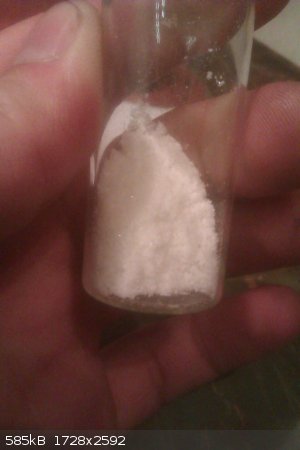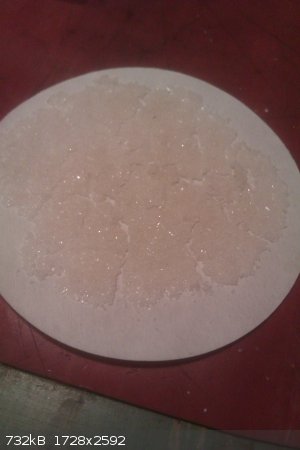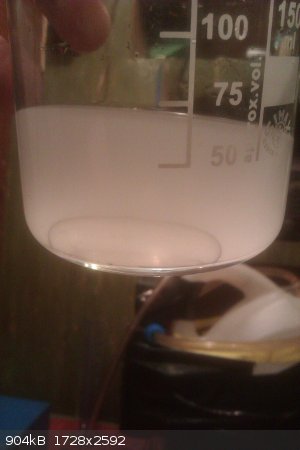lowtech
Harmless

Posts: 7
Registered: 31-7-2018
Member Is Offline
Mood: reactive
|
|
Solventless methylation with dimethyloxalate
Hi. Im new here, but it´s a long time that im studying organic chemistry and in my free time doing some experiments occasionally, i really like
chemistry and possibilities of making new useful substances. Method im presenting here isnt obviously suitable for more complicated substrates with
ester or halogen moieties, which could be destroyed by high temperatures and basic enviroment. Further experimenting should be done on this reaction,
but i dont have any more suitable substrates. For methylating simple phenols, or tiophenols this method offers solvent free conditions, avoiding nasty
and carcinogenic reagents like DMS or MeI, except the toxic methanol use, and offers very simple work-up with steam distillation of a product. Yields
vary from good to low (22-77 %). Also my english isnt very good, so im sorry about that  . .
It is a long time that i was trying to methylate one substrate (2-mercaptohydroquinone), but all my attempts failed because of my lowtech home
equipment and lack of appropriate reagents. Firstly, i was trying to use methyl chloride/acetone/NaI/K2CO3 approach, but the reaction never goes to
completion and it was extremely slow. Discouraged i started to browse internet and reaxys about OTC methods to methylate hydroxy groups without DMS or
MeI, and found method using MeBr on this forum, and also a methods using dimethyl carbonate, trimethylphosphite and trimethylsulfonium bromide.
Because i dont have access to many chemicals, only methyl bromide method seemed promising, so i gave it a go. And story about my stupidity started
here... 
Of course, i knew that MeBr is poisonous gas, but i underestimated its potency. I have done my calculations, measure reactants, set up a MeBr
generator, fill a boiling flask with KBr, MeOH and H2SO4, PVC tubing leads to a pasteur pippete drowned into the solution of 2-mercapto HQ and KOH in
MeOH. Everything looks good, i started to heat the MeBr generator flask, it happily bubbled trough a solution, but in few minutes, it started to
deacrese, bubbles were smaller and smaller, but on the other side reaction in the generator seemd to accelerate. I dont care about that much, thinking
that it just dissolves so rapidly into the solution, but all of a nothing, a cork popped out of the flask and some of H2SO4/MeOH mixture splashed out
on to hotplate, filling a hood (very small with not very efficient fan) with MeBr gas. On the inside of a pasteur pippette, the KBr from reaction of
mercapto HQ salt and MeBr crystallizes out and clog it so the pressure build up and... Firstly I was shocked, starting to quickly clean up the acid
and MeOH splash, and accidentally take several whiffs of gas. An hour after, i started to feel dizzy, the symptoms peaked next day morning with
difficult breathing, strong headaches and very bad feeling that my lungs hurt. After a week or so it gets better, but this experience makes me more
cautious and blocked me from repeating this path.
Then i discovered a paper about alkylation with methyl oxalate in DMF solvent, and authors claimed good yields of alkylated phenols, tiophenols and
amines by reaction of dimethyloxalate, K2CO3 and substrate in boiling DMF. Also this paper leads me to first published alkylation method with
dimethyloxalate from japanese journal, where authors made a sodium or potassium salt of phenol by reaction of sodium methoxide solution with it, then
they added DMO, evaporate MeOH and baked a solid at 250°C for one hour. Also pdf´s are attached. I do not have acces to DMF and also sodium to make
sodium methoxide, but i decided to figure out how to do it differently. I chose a hydroquinone as a testing phenol, because i already have a bottle of
it for making foto developers.
The boiling DMF said that reaction needs a temperature 150°C and higher to proceed smoothly, but this milder-looking method is using K2CO3 as a base,
not the alkoxide. I was thinking a lot about a good solvent for the reaction which dont interfere with K2CO3 and could be separable from product in
the end. Dioxane, dimethyldioxane, toluene, baby oil, ethylene or propylene glycol was the only choices for me and all had some bad property (low bp,
poor solubility of reactants, possible alkylation of solvent). Thinking of it i realised that DMO has a low melting point (around 50°C) and
sufficently high boiling point near 160°C and its polar, so in excess it could act as a some sort of solvent for reaction. So i made a first reaction
„solventless“, only using a 4 equivalents of DMO and 2,2 eqivalents of K2CO3 to hydroquinone, and heated the flask directly on hotplate to 200-250
°C. Immediately after DMO melted, mixture started to foam and darken, ending with solid brown cake after 30 minutes of heating. After cooling, adding
NaOH solution to it and steam distillation, i ended with small ammount of white solid crystallizing in the condenser. The yield of
1,4-dimethoxybenzene was 26%. With this technique i also tested a reaction with 2-mercaptohydroquinone, using 6 equivalents of DMO and 4 equivalents
of K2CO3. I baked it at 250°C and steam distill the solid with NaOH solution, and i obtained very low, 13 % yield of desired product.
Encouraged by this proof that reaction could be done this way, i figured out a major problems lowering a yield. Firstly, i found that my potash isnt
dry, so i baked it at 300°C on a hotplate to get relatively anhydrous reactant. Also my dimethyl oxalate wasnt acid free (not perfectly stripped of
sulfuric acid from reaction), so i recrystallized it one more time from methanol. But a major issue was formation of a hydroquinone salt during the
heating. The reagents are not mixed properly, because they are solid, and hydroquinone haven´t a good chance to make a reactive dipotassium salt. I
tried to make it separately by mixing ethanolic KOH with solution of HQ in EtOH, but the dipotassium salt is so air sensitive that it could not be
filtered or dryied because of oxidation. A nice yellowish precipitate formed as ethanolic KOH meets solution of hydroquinone, but it started to dakren
considerably, and attempt to filter it on a frit ended after 10 seconds or so because of very strong heating of material inside, turning to black
powder. So i tried to make it directly in the flask by simply adding a squirt of methanol. And THIS worked. Similarily as before, i
mixed 4 eqivalents of DMO, 3 eqivalents of K2CO3 to hydroquinone, heated a mixture to the point when a DMO starts to melt, and quickly pour in few ml
of methanol. Mixture starts to boil, almost everything except K2CO3 dissolved, MeOH was evaporated and a mixture was baked at 200-250°C on a hotplate
for 30 mins. Steam distillation this time gave me 77% yield of dimethoxybenzene as white crystalline solid  . .
With this succes i run a reactions with 2-mercaptohydroquinone and pyrocatechol to test another substrates and generality of this method.
Experimental
The hotplate used is a normal kitchen cooking hotplate, which could heat to 300°C. The temperatures for reactions and melting points were measured
with K-type thermocouple digital thermometer (the digital reader from Aliexpress, but i replaced given probe with another K-type probe from local
reliable company). I know, piece of crap, but i dont have any better. For reactions, im using a 250 ml erlenmeyer flask. It is important to use a flat
bottomed flask with good surface area on the bottom, where the material can be spread evenly to thin layer.
Methanol used was purchased from local chemical supplier and wasnt dried before use, but claims to be 99,0% p.a.. Potassium carbonate was dried by
heating it to 300°C on a hotplate. Dimethyl oxalate was made by sulfuric acid method from oxalic acid and methanol following a procedure from
OrgSynth (link included). It was recrystallized one more time tho, because after following the exact procedure, it was still damp and somewhat acidic.
Hydroquinone and pyrocatechol used are old Merck supplies for photo developers. 2-mercapto hydroquinone was made by thioxolone approach from
benzoquinone and urea in two steps, following a procedure from this forum (link at the end).
1,4-dimethoxybenzene preparation
To 250 ml Erlenmeyer flask was added 2,70 g (24,5 mmol; 1 equiv.) of hydroquinone, 10,2 g (73,8 mmol; 3 equiv.) of potassium carbonate and 11,8 g
(0,1 mol; 4 equiv.) of dimethyloxalate crystals. Flask was heated on a plate to the point when the dimethyloxalate starts to melt on the sides of a
flask, and then 5 ml of methanol were added quickly and the flask is heated strongly at 250°C and swirled during a boiling. When methanol and traces
of water boils off, mixture started to smoke and turning more dark brown colour, and a sweet smell of dimethoxybenzene is noticed. At this point,
there is added approx. 15 cm glass tube with groung glass joint as small air „condenser“ to help a hot vapors of DMO and product stay in the
flask. The heat is applied for 30 minutes, then the mixture is allowed to cool. Approximately 5g of NaOH are mixed with 150 ml of water, this is
poured in to the flask with reaction mixture, some boiling stones are added and mixture is steam distilled directly from the flask to give 2,61 g (77
% yield on starting hydroquinone, m.p. 53-53,5 °C) of 1,4-dimethoxybenzene as white crystalline solid which solidifies mostly in the condenser.The
product give no color change reaction with Fe3+ ions.
2-methylthio-1,4-dimethoxybenzene preparation
To the 250 ml Erlenmeyer flask is added 4,00 g (28,2 mmol; 1 equiv.) of 2-mercaptohydroquinone, 20,0 g (0,17 mol; 6 equiv.) of dimethyl oxalate
and 15,5 g of dry K2CO3 powder (0,11 mol; 4 equiv.). Flask was heated till the DMO starts to melt, then 5 ml of methanol were added, mixture swirled
when boiling, the methanol is boiled off the flask, then smoke appears inside and a strange, not very plesant smell combinig a cabbage and
dimethoxybenzene, was noticed. At this point the 15 cm ground glass tube acting as a small air condenser was attached and mixture was heated at
200-250°C for 30 minutes. After cooling, there is poured 150 ml of water containing 5 g of NaOH and the resulting dark mixture is steam distilled to
give about 1,5 ml of dark brown oil which slowly crystallizes in cold (5°C) to brown crystalline paste. This was washed 2 times with 20 ml of water
and then stripped of brown liquid as much as possible on a frit. Resulting brownish crystals were pressed between filter papers unil completely white.
Yield of 2-methylthio-1,4-dimethoxybenzene as a sugar like white crystaline solid (1,17 g; m.p. 31-33°C) was 22 %. The product give no color change
reaction with Fe3+ ions. Steam distillation is slow and water is refilled to the boiling flask few times, and a product come out much more cleaner at
the end of the distillation.
1,2-dimethoxybenzene (veratrole) preparation
250 ml Erlenmeyer flask was charged with 2,70 g (24,5 mmol; 1 equiv.) of pyrocatechol, 10,2 g (73,8 mmol; 3 equiv.) of potassium carbonate and
11,8 g (0,1 mol; 4 equiv.) of dimethyloxalate crystals. The solid mixture was heated until dimethyloxalate started to melt at the sides of a flask and
5 ml of methanol was poured into the mixture, heated on a plate at 250°C, swirled when methanol is boiling away. Soon mixture starts to foam, but
this was under control and foam sat down at the bottom of a flask. At this point there is attached a 15 cm ground glass tube acting as additional air
condenser (needed here because of high volatility of product) and heating continued for 30 minutes at 250°C. Mixture cooled a little, and when it can
be touched by hand, there is added 150 ml of water containing 5g of NaOH. Brown-black suspension was steam distilled and a oily transparent colorless
liquid was collected. The distillation was fast and it took only 50 ml of distillate to drive off all of the product. The yield of veratrole (approx.
2,25 ml/2,38 g; colorless oil with strong aromatic sweet and minty like aroma; m.p.: 17-17,5°C) was 70 %.
I think this method is applicable to many more substrates, which bears hydroxy or mercapto groups (one or more of them). It seems that more
hydroxy/mercapto groups on the substrate lowers a yield considerably. But to be honest, the 2-mercapto hydroquinone i used wasnt especially pure, and
stored about a year or so on the shelve, so yield with pure material could be higher.
When a steam distillation of 2-mercaptohydroquinone reaction was carried out, a significant ammount of a distillate (assuming 25-30% of oily residue)
consisted of some brown colored liquid, which didnt solidify with product in the fridge. But when it was vacuum filtered, it passes trough a frit
leaving off white crystals of product. I dont have a clue what this impurity is, but the fact it comes out at the start of a distillation could mean
it has a higher vapor pressure, thus a lower boiling point.
I currently dont have acces to any kind of spectral analysis which can prove that product is clean. But all products melted quite sharply and had
crystallized properly, melting points were a bit off a range claimed by wikipedia, but thermometer i used is probably a piece of crap.
So maybe this can be useful for somebody who dont have acces to common methylating agents, or havent got a good safety equipment to perform reactions
with them.
Link for preparation of 2-mercaptohydroquinone here
Link for preparation of dimethyloxalate here
Attachment: DMO methylation K2CO3.pdf (615kB)
This file has been downloaded 370 times
Attachment: methoxide japanese article.pdf (1.3MB)
This file has been downloaded 353 times
[Edited on 1-8-2018 by lowtech]
[Edited on 1-8-2018 by lowtech]
|
|
|
lowtech
Harmless

Posts: 7
Registered: 31-7-2018
Member Is Offline
Mood: reactive
|
|
also some photo of products  sorry for the "quality" but i do not have camera in
the hand sorry for the "quality" but i do not have camera in
the hand 
liquid in the beaker is veratrole right after steam distillation
crystalline solid on the filter paper is 2-methylthio-1,4-dimethoxybenzene
and white solid in the vial is 1,4-dimethoxybenzene 
  
|
|
|
|